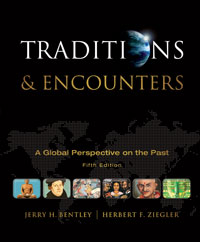
Traditions and Encounters, AP Edition (Bentley), 5th EditionChapter 9: State, Society, and the Quest for Salvation in IndiaOverviewThis chapter addresses the significant developments in classical India between about 520 B.C.E. and 550 C.E., during which two influential empires emerged in northern India: the Mauryan and the Gupta. Although these two state systems were not permanent, they contributed to the growth of long-distance trading networks, the consolidation of cultural traditions, and the promotion of several significant religions. More specifically, India, during this period of one thousand years or so, witnessed the following important developments:
|  |















